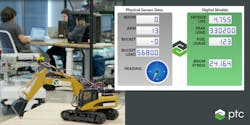Digital Twin Technology Highlighted with Excavator Demo
The digital twin concept has been gaining a lot of traction over the past couple of years due to its potential in a number of industrial applications—from virtual commissioning and energy efficiency to line and plantwide production optimization. Despite its clear potential, real-world applications of digital twin technology have been a bit slow to catch on as industry grapples with a confluence of new Internet of Things (IoT) technologies, including cloud and edge computing, big data analytics, and remote equipment access.
Read about how to get started with digital twin technology.
In an effort to highlight the impact of digital twin technology and make it more accessible, PTC built a digital twin demo of a scale model excavator to illustrate the possibilities presented by linking the physical and digital worlds with digital twins. To do this, PTC retrofitted the excavator with compute power via a Raspberry Pi3 to harness telemetry data from pressure sensors and linear potentiometers that monitor the stroke of the cylinders and load in the bucket. The Raspberry Pi on the excavator contains an edge client implemented using the ThingWorx JavaSDK software development kit.
“This SDK acts as the gateway to transmit data off the excavator to a cloud-based ThingWorx server where there is an array of integrated technologies and powerful simulation models,” said Greg Brown, senior director of PTC’s worldwide CAD business development team, who created the demo. “This technology foundation is key for rolling out the next-generation digital twin use cases such as predictive maintenance, operational intelligence, or product design optimization, among others.”
Brown explains that, when managing real-time assets with digital twins, an IIoT platform is needed to contextualize the sensor data through the asset’s digital definition, including the 3D models and the engineering calculations and parameters. "In this case, PTC identified relevant properties from the sensor feeds in ThingWorx, including the excavator arm and boom angles, bucket angle, bucket load, and other movements, which provide the foundation for several engineering simulations and artificial intelligence/machine learning (AI/ML) models,” he said.
This model highlights the usefulness of the digital twin because it’s not practical to monitor all items of interest with a sensor, such as the center of gravity calculation, said Brown, adding, “So we look to the digital twin to fill out the rest of those insights.”
Some of the additional insights provided by the digital twin for the excavator demo include tip danger, fatigue life estimation, arm stress analysis, and fuel efficiency. Development of these digital twin simulations were aided by PTC’s Creo and Windchill configurations and orchestrated with ThingWorx.
“An on-the-fly simulation calculating the risk of the excavator tipping over based on center of mass and gravity calculations leverages inputs from sensors and operating conditions from the physical machine,” said Brown. “As the arm extends further away from the excavator, weight is unevenly distributed and increases the tip risk. Setting the system up with alert thresholds can preemptively warn the operator in real time to prevent accidents or be logged in ThingWorx for post-incident analysis.”
Brown noted that linking the sub-assembly components in the digital twin, such as a part of the base of the boom, enables them to be used as indicators for stress analysis and simulations, which could prevent costly downtime for industrial enterprises. Today these types of calculations are lengthy, costly, and limited to theoretical scenarios rather than informed by actual use. “By baking in assumptions, such as amplitude of cyclic loads and monitoring peak loads, the model can inform fatigue analysis of the excavator. Using Creo-as-a-Service, the component data is only triggered on demand—when peak load parameters are breached—and then updated in ThingWorx, increasing uptime and lifetime of the asset,” he said.
Creo Simulate was used to run several different design scenarios, train a neural network using deep learning techniques, and embed a lightweight predictor model on the Raspberry Pi. “The neural network, operating at the edge, provides real-time predictions of maximum stress in the boom based on sensor data,” said Brown. “Leveraging AI/ML-based simulations at the edge can optimize compute power with embedded complex simulations. The resulting ability to bolster predictive maintenance with the use of digital twins for heavy industrial assets is a potential game changer.”
With real-time telemetry data from the excavator, such as engine speed/load, and qualitive factors, such as operator information and weather conditions, PTC can predict fuel consumption per hour with the digital twin model, according to Brown. “Using Mathcad-as-a-service to dynamically provide these updated calculations, the user can monitor predicted fuel usage and assess the efficiency of the excavator on an operator-by-operator basis based on actual usage.”
Beyond mechanical insights, digital twin technology can also be used to offer insights to people in different roles, said David Immerman, a PTC business analyst. For example, digital twins can provide a crucial feedback loop to product engineers and designers to improve future iterations of new products and generative design capabilities. "The excavator performance KPIs [key performance indicators] can also be used to assess an operator’s performance and train junior operators through augmented reality [AR] experiences. In addition, real-time models can inform service technicians of potential failures in a system, while AR provides the lens to the digital twin to service the physical machine in-situ.”
Applying simulation models to real-world performance data of heavy industrial assets can dramatically reduce downtime, said Immerman. “And with supporting technologies like IoT and cloud computing, these digital twin implementations will increasingly become widespread and impactful.”
About the Author
David Greenfield, editor in chief
Editor in Chief

Leaders relevant to this article:
